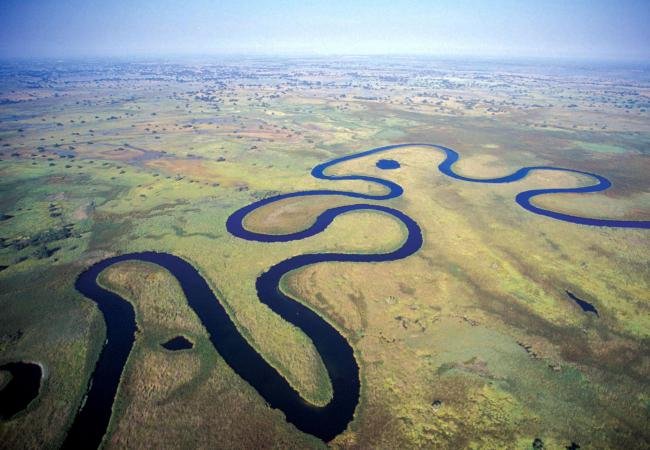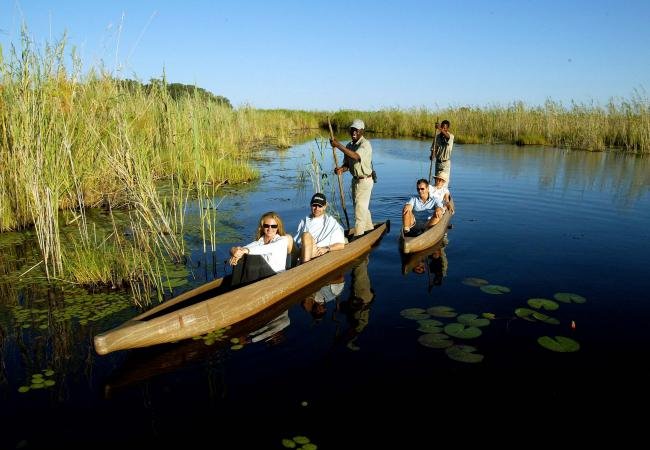Okavango Delta
One of the most sought after wilderness destinations in the world, the Okavango Delta gives entrance to the spectacle of wild Africa such as dreams are made of – the heart-stopping excitement of big game viewing, the supreme tranquility and serenity of an untouched delta, and evocative scenes of extraordinary natural beauty.
A journey to the Okavango Delta – deep into Africa’s untouched interior – is like no other. Moving from wetland to dryland – traversing the meandering palm and papyrus fringed waterways, passing palm-fringed islands, and thick woodland, resplendent with lush vegetation, and rich in wildlife – reveals the many facets of this unique ecosystem, the largest intact inland delta in the world.
The Okavango Delta is situated deep within the Kalahari Basin, and is often referred to as the ‘jewel’ of the Kalahari.
That the Okavango exists at all – deep within this thirstland – seems remarkable. Shaped like a fan, the Delta is fed by the Okavango River, the third largest in southern Africa. It has been steadily developed over the millennia by millions of tonnes of sand carried down the river from Angola.
Swollen with floodwaters from the summer rains, the Okavango River travels from the Angolan highlands, crosses into Botswana at Mohembo in the Caprivi, then later spills over the vast, fan-shaped Delta. The timing of the floods is uncanny. Just as the waters from Botswana’s summer rains disappear (April, May), so the floodwaters begin their journey – 1300 kilometres of which is through Kalahari sands – revitalising a vast and remarkably diverse ecosystem of plant and animal life.
The water’s flow, distribution and drainage patterns are continually changing, principally due to tectonic activity underground. As an extension of Africa’s Great Rift Valley, the Okavango is set within a geographi-cally unstable area of faults, and regularly experiences land movements, tremors and minor quakes. By the time the water reaches Maun, at the Delta’s southern fringes, its volume is a fraction of what it was. As little as two to three percent of the water reaches the Thamalakane River in Maun, over 95 percent lost to evapo-transpiration.
But the flow doesn’t stop in Maun. It may continue east to the Boteti River, to fill Lake Xau or the Makgadikgadi Pans, or drain west to Lake River to fill Lake Ngami.
There are three main geographical areas:
the Panhandle
the Delta
dryland
The Panhandle begins at the Okavango’s northern reaches, at Mohembo, extending down for approximately 80 kilometres. Its corridor-like shape is contained within two parallel faults in the Earth’s crust. Here the river runs deep and wide and the swamps are perennially flooded. The dominant vegetation is vast papyrus beds and large stands of phoenix palms. The main tourist attractions of the Panhandle are fishing, birding and visiting the colourful villages that line its western fringes.
At Seronga, the fan-shaped Delta emerges, and the waters spill over the Delta, rejuvenating the landscape and creating stunning mosaics of channels, lagoons, ox-bow lakes, flooded grasslands and thousands upon thousands of islands of an endless variety of shapes and sizes. Many of the smaller islands are grandiose termitaria built by fungus-growing termites, one of 400 termite species in Africa, whose fantastic structures are a source of refuge and food for many animals.
The Delta region of the Okavango can vary in size from 15 000 square kilometres during drier periods to a staggering 22 000 square kilometres during wetter periods. Its dominant plant species are reeds, mokolwane palms, acacia, sycamore fig, sausage trees, raintrees and African mangosteen.
At the Delta’s lower reaches, the perennial swamps give way to seasonal swamps and flooded grasslands. To the southeast the third vegetation region becomes evident, as it changes to true dryland. There are three major land masses here: the Matsebi Ridge, Chief’s Island and the Moremi tongue. Here the vegetation is predominantly mophane, acacia and scrub bush and the land is dotted with pans. It is to this region that large numbers of mammals retreat during the dry winter months.
Major tourist attractions in the Delta and the dryland areas are game viewing, birding and boating, often in the traditional mokoro. The diversity and numbers of animals and birds can be staggering. A recent overview of the Okavango records 122 species of mammals, 71 species of fish, 444 species of birds, 64 species of reptiles and 1300 species of flowering plants. A successful rhino reintroduction programme in the Okavango now puts the population of White Rhino at approximately 35, and Black Rhino at 4.
Major species to be seen include:
elephant |buffalo | giraffe | zebra | hippo | crocodile | rhino | red lechwe | waterbuck | reedbuck | duiker | impala | kudu | steenbok | wildebeest | hartebeest | sable | roan | tsessebe | lion | leopard | cheetah | genet | serval | and caracal | along with an immense variety of birds – land and water, resident and migratory, some of which are rare and endangered.
It should be noted, however, that game viewing very much depends on season, and water and food availability.
The Okavango is a proposed World Heritage Site. Its long-term conservation is ensured through government policy and regulations (though only Moremi Game Reserve has an official protected status), the efforts and initiatives of camps and lodges in its concessions, the recently launched Okavango Development Management Plan (ODMP) and its status as a Ramsar site, under IUCN, an agreement that limits its utilisation and development.

Hi! I am a robot. I just upvoted you! I found similar content that readers might be interested in:
https://reserveabooking.wordpress.com/2017/03/14/explore-botswanas-okavango-delta/
hey thanks appreciate it.